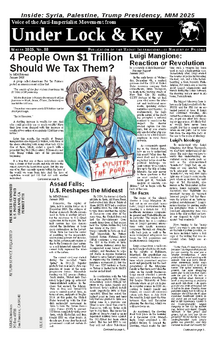
Commemorating Mary Crow Dog, AIM and the BPP

This month the Brown Berets - Prison Chapter (BB-PC) honors Mary Crow Dog, born Mary Blue Bird. She was a resident of a town called Saint Francis on the reservation of Rosebud during 1973 at the siege of Wounded Knee.
In 1971 Mary joined the American Indian Movement (AIM). During the siege at Wounded Knee Mary was tasked with organizing the women to do the cooking, cleaning and communications. She organized food running and getting in and out of Wounded Knee to get much-needed supplies. The siege lasted 73 days, with the Bureau of Alcohol, Tobacco, and Firearms (ATF) and Federal Bureau of Investigation (FBI) using armored personnel carriers and Huey helicopters. Mary helped keep morale up among everyone at the camp. Her bravery and courage is why my family in Pine Ridge and Rosebud have the freedoms we do today.(1)
MIM(Prisons) responds: The BB-PC sent us these words on Mary Crow Dog, along with some notes on the documentary on the Black Panthers that we reviewed in ULK 49. We thought it appropriate to print something on the AIM in this issue, as they are very relevant to understanding the conditions in the United $tates during the time of the Black Panther Party. While the BPP can brag of having most of the FBI actions of the time targeting them, this is probably due mostly to the size of the New Afrikan nation and their mass base, compared to the First Nations who have been decimated by genocide. And while Panthers engaged in long shoot outs with police, nothing compared to the U.S. Army invasion of Wounded Knee:
“In the first instance since the Civil War that the U.S. Army had been dispatched in a domestic operation, the Pentagon invaded Wounded Knee with 17 armored personnel carriers, 130,000 rounds of M-16 ammunition, 41,000 rounds of M-1 ammunition, 24,000 flares, 12 M-79 grenade launchers, 600 cases of C-S gas, 100 rounds of M-40 explosives, helicopters, Phantom jets, and personnel…”(2)
Churchill and Vander Wall document the details of the intensive war the FBI led against AIM. They write about the pursuit of AIM founder Dennis Banks as having “garnered the dubious distinction of becoming the most sustained attempt at a federal prosecution in the history of American jurisprudence.”(3) While on the run from the state in 1976, Banks is reported to have been hidden by Chican@ leader Corky Gonzalez, and members of the Crusade for Justice working with local AIM members. Later that year, Corky Gonzalez was falsely accused by the FBI of possessing “a rocket launcher, rockets, M-16 automatic rifles, and hand grenades,” intended to use in combination with AIM and others to kill police.(4) Such rumors were part of the FBI’s public relations war against liberation movements, attempting to distract from the fact that the U.$. government is the real perpetrator of violence.
The American Indian Movement was formed in 1968, in a rising movement for national liberation among First Nations that paralleled that in New Afrika. Forming two years after the Black Panther Party, like many, they were inspired by and modeled themselves after the BPP, though not taking up the explicit Maoism of the BPP or the Young Lords Party. Like the Panthers, AIM saw chapters pop up across the country soon after its founding. And like the Panthers, AIM promoted armed self-defense of its people and territory.
It is worth noting the different conditions faced by First Nations compared to other internal semi-colonies. The threat of annihilation, and the clear recognition of territory rights, lead to a more advanced national consciousness and more advanced conditions for national struggle. While we take lessons from the BPP’s ultra-left tendency to pick up the gun too soon, the conditions of the time – from the First Nation reservations in the United $tates to Vietnam to China – makes their decision much more understandable than it would be today. Even today, we recognize the objective conditions among First Nations overall to be more advanced and armed struggle to be a correct path for them before it would be in other parts of the United $tates.
Related Articles:








